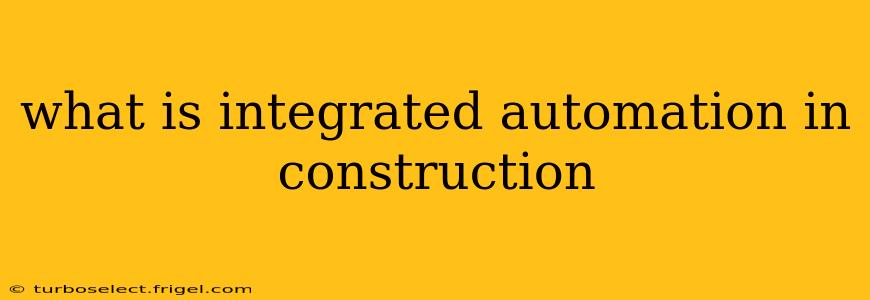Integrated automation in construction refers to the synergistic use of various automated technologies to streamline and optimize construction processes. It's not just about using individual pieces of automated equipment; it's about connecting them, integrating their data, and using that information to make smarter, more efficient decisions throughout the entire project lifecycle. This holistic approach leads to significant improvements in productivity, safety, and cost-effectiveness.
Instead of isolated robotic arms or automated concrete pourers, integrated automation involves a complex network of interconnected systems. These systems might include:
- Building Information Modeling (BIM): A digital representation of the physical and functional characteristics of a facility. BIM serves as the central hub, providing data to all other automated systems.
- Robotics and Automation: From robotic bricklaying to automated welding and 3D printing of building components, robots perform repetitive tasks with greater speed and precision.
- Autonomous Equipment: Self-driving vehicles and machinery operate with minimal human intervention, improving efficiency and safety on construction sites.
- IoT Sensors and Data Analytics: Sensors embedded in equipment and structures collect real-time data on progress, material usage, and environmental conditions. Advanced analytics process this data to provide actionable insights.
- Artificial Intelligence (AI) and Machine Learning (ML): AI and ML algorithms analyze data from various sources to predict potential problems, optimize scheduling, and improve resource allocation.
- Digital Twins: A virtual representation of the physical construction project that mirrors its progress in real-time, enabling proactive problem-solving and improved decision-making.
What are the benefits of integrated automation in construction?
The benefits extend far beyond simply automating individual tasks. Integrated automation delivers a multifaceted improvement across the entire project:
- Increased Productivity and Efficiency: Automation significantly accelerates construction processes, reducing labor costs and project completion times. Automated systems work continuously and precisely, minimizing human error.
- Enhanced Safety: Automated systems reduce the need for workers to perform dangerous or repetitive tasks, minimizing risks of accidents and injuries. Real-time monitoring of environmental conditions and equipment performance adds another layer of safety.
- Improved Quality and Accuracy: Automated systems perform tasks with greater precision than humans, resulting in higher-quality construction and fewer defects.
- Reduced Costs: While the initial investment in automated technology can be substantial, the long-term cost savings from increased efficiency, reduced labor costs, and minimized waste often outweigh the upfront investment.
- Better Collaboration and Communication: Integrated systems facilitate better data sharing and collaboration among different stakeholders, enhancing communication and coordination.
- Sustainable Construction Practices: Automation can lead to more efficient use of materials and resources, reducing waste and promoting environmental sustainability.
How does integrated automation impact different stages of construction?
The impact is pervasive across all project phases:
- Planning and Design: BIM and AI algorithms optimize designs for constructability and cost-effectiveness.
- Procurement and Logistics: Automated systems optimize material ordering and delivery, minimizing delays and waste.
- Construction: Robotic systems and autonomous equipment accelerate the actual building process.
- Monitoring and Control: Real-time data and analytics enable proactive problem-solving and adjustments.
- Commissioning and Handover: Digital twins facilitate a smooth transition to the operational phase.
What are the challenges of implementing integrated automation in construction?
Despite its numerous benefits, implementing integrated automation faces several hurdles:
- High Initial Investment Costs: The cost of acquiring and implementing automated technologies can be significant.
- Lack of Skilled Workforce: Operating and maintaining complex automated systems requires specialized skills and training.
- Data Integration and Interoperability: Seamless integration of data from various systems is crucial but can be technically challenging.
- Cybersecurity Risks: Connected systems increase the risk of cyberattacks and data breaches.
- Regulatory and Legal Issues: Regulations related to the use of automation in construction might vary and need to be carefully considered.
What are some examples of integrated automation in construction?
Several projects worldwide are showcasing the benefits of integrated automation. These include the use of:
- Robotic bricklaying systems that significantly increase the speed and accuracy of bricklaying.
- Automated concrete pouring and finishing systems improving efficiency and quality.
- Autonomous surveying drones collecting precise data for site planning and monitoring.
- Digital twins used for real-time monitoring and proactive risk management.
Is integrated automation the future of construction?
The evidence strongly suggests that integrated automation is not just a trend, but a fundamental shift in how construction projects are executed. While challenges remain, the long-term benefits of increased efficiency, improved safety, and enhanced quality make it a compelling solution for the future of the industry. The industry is constantly evolving, and ongoing innovation will surely address many of the current challenges.
